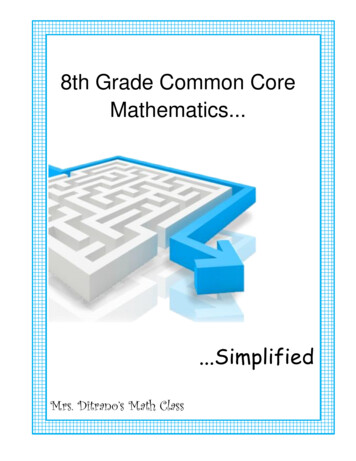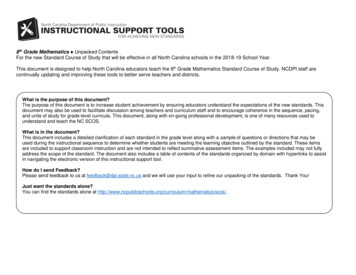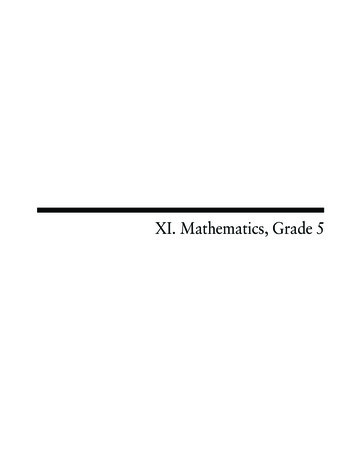
Transcription
8th Grade Common CoreMathematics.SimplifiedMrs. Ditrano’s Math Class
A function is a rule that assigns to each input exactly one output.These are graphs of functions:(every x-coordinate is different)These are NOT the graphs of functions:(x-coordinates are the same for more than one point)The VERTICAL LINE TEST can be used to determine if a relation isa function. If a vertical line can be drawn that intersects therelation more than once, then the relation is NOT a function.If the vertical line only intersects the relation once, then therelation IS a function.These are tables of functions:(every x-coordinate is different)These are NOT tables of functions:(x-coordinates are the same for more than one point)The coordinates of a function: {(1, 6), (2, 3), (4, 3), (5, 7)} each x is only used onceNOT the coordinates of a function: {(1, 6), (2, 3), (1, 3), (5, 7)} one x is paired with two y’s
Slope,constant rate of change(line climbs this way)Linear Equationsdo not includeexponents,variables in thedenominator orabsolute value.y-intercept,initial value(Start here)To graph a line from the equation, start at the y-intercept,then count up (or down if the slope is negative) and right,according to the slope, to find another point on the line.Connect the dots . Label the line.2EXAMPLE: y x – 53Start at (0, -5), go up 2, right 3, plot a point.Use the same skill to write theequation of a line from a graph:To write the equation of a line from a table, find the y-intercept by finding thevalue of y when x 0. Calculate the slope by determining the patterns in the ycolumn and x-column and write them in fraction form𝑐ℎ𝑎𝑛𝑔𝑒 𝑖𝑛 𝑦𝑐ℎ𝑎𝑛𝑔𝑒 𝑖𝑛 𝑥y- intercept 3slope 𝟑𝟐.
Two Way TablesExample QuestionEmma has collected information about the cats and dogs that children in her classhave as pets. For each pupil, there are four possible responses they could make: The pupil has a cat and a dog.The pupil has a cat but not a dog.The pupil has a dog but not a cat.The pupil does not have a cat or a dog.If we were given the following data, the table would look like this:8 pupils have a cat and a dog.4 pupils have a cat but not a dog.12 pupils have a dog but not a cat.6 pupils do not have a cat or a dog.6To calculate the relative frequency, compare the amount in a category to the totaland convert that ratio into a percent.Example: What is the relative frequency of the number of pupils who do not havea cat or a dog (6) to the total (30)?630 6 30 x 100 20%Values are not always compared to the grand total. Sometimes, the total is theamount in a category. Example: Out of the pupils that have dogs (8 12 20),what percent also have cats(8)?820 8 20 x 100 40%
nPositive Association: data points have an upward trend(as one variable increases, so does the other one)Negative Association: data points have a downward trend(as one variable increases, the other one decreases)No Association: data points have no trendOutlier: numerically distant fromthe rest of the dataCluster: a group of data points Line of Best Fit: A straightthat are close togetherline drawn through the centerof a group of data points
𝐿𝑎𝑤𝑠 𝑜𝑓 𝐸𝑥𝑝𝑜𝑛𝑒𝑛𝑡𝑠When the base is the same, you can simply add the exponentswhen multiplying.𝟓𝟑 x 𝟓𝟔 𝟓𝟗When the base is the same, you can simply subtract theexponents when dividing.𝟖𝟕 𝟖𝟐 𝟖𝟓A negative exponent indicates that the value is the reciprocalof that value with a positive exponent.𝟏𝟕 𝟐 𝟒𝟗(34)5 320Any number raised to the power of zero, except zero itself,equals one.𝟏𝟑𝟎 1
Numbers written in scientific notationmust be in the form:a x 10na is greater than or equal to 1 but less than 10n is an integer that represents the number of placesthe decimal point moves to write the number instandard formpositive exponent: move the decimal point to therightnegative exponent: move the decimal point to theleftExamples: Scientific NotationStandard Form9.43 x 106 9,430,0004.019 x 10-3 0.004019When solving word problems, remember the phrase, “howmany times” means to divide.Try this: The temperature at the surface of the sun is approximately 1.0 x 104degrees Fahrenheit. The temperature at its center is approximately 2.7 x 107degrees Fahrenheit. About how many times greater is the temperature at thecenter of the sun than at its surface?
Translation: figure moves according to a rule;image is congruent to original figureRight: Add to x-coordinateLeft: Subtract from x-coordinateUp: add to y-coordinateDown: subtract from y-coordinateReflection: mirror image over given line; each point on the figurewill be the same distance from the line of reflection, but on theopposite side of the line; image is congruent to original figureRotationRotation : the figure turns clockwise or counterclockwise; image iscongruent to original figure90o one turn180o two turns270o three turnsDilation:figure shrinks or enlarges according to a scale factor (multiply ALLDilationcoordinates by that scale factor); image is similar but NOT congruent tooriginal figure
Complementary anglesSupplementary anglesadd up to 90o.add up to 180o.Vertical angles are congruent.Corresponding anglesare congruent.Alternate interior anglesSame side interior anglesare congruent.are supplementary.Alternate exterior anglesSame side exterior anglesare congruent.are supplementary.*To solve algebraic pairs of angles problems, first determine the relationship between theangles in question, then write an algebraic equation and solve for the variable.Substitute your answer into the given expression to calculate the measure of the angle.
Have proportional side lengths Have the same slope Have congruent anglesstatesthat if two angles in one triangleare congruent to two angles inanother triangle, the triangles aresimilar.that the exterior angle of a triangleequals the sum of the twonon-adjacent interior angles.A C Dstates that the length of thethird side of a triangle must beless than the sum and greaterthan the difference ofthe other two sides.
Simplify (apply the distributive property, if possible, thencombine like terms).Isolate the variable by using inverse operations.Check your answer.Example: 4(x 1) – 3x 18 9x – 10This equation has one solution:4x 4 – 3x 18 9x – 10x 4. If you end up with x x,there are infinite solutions tox 22 9x – 10-9x– 9x-8x 22 -10-22that equation. If you end upwith two numbers that are notequal, there are no solutions to-22-8x -32-8Check: 4(4 1) – 3(4) 18 9(4) – 104(5) – 3(4) 18 9(4) – 1020 – 12 18 36 – 108 18 36 – 1026 26multiply the entire(See Systems of Equationsfor more information.)-8x 4To eliminate fractions,that equation.equation by the LCM ofthe denominators first.𝟐𝟓𝟓𝟖Solve for x: x – 15 x – 16
Systems of EquationsThe solution to a system of equations is the set of variables that make all equationstrue. On a graph, this is the point where the lines intersect. Three ways to solve asystem of equations are:Graphing:Substitution: replace onevariable with an equivalent valueThis equation has oneExample: x 3y 2x 5y 2(3) 5y 6 5y 11Solution: (3, 11)solution: (3, 11). If you end upwith x x, there are infinitesolutions to that equationwhich means it is actually thesame line in each equation. Ifyou end up with two numbersthat are not equal, there areno solutions to that equation.This means that the lines areparallel and will neverintersect on a graph.Elimination:combine the equations by adding or subtracting them toeliminate one variable and solve for the other variable.2x 5y 462x 3y 30Subtracting eliminates ‘x’2x 5y 46- 2x 3y 302y 1622y 8Substitute 8 for ‘y’(in either equation)to solve for ‘x’.Solution: (3, 8)Try This: The math club and thescience club had fundraisers to buysupplies for a hospice. The math clubspent 135 buying six cases of juice andone case of bottled water. The scienceclub spent 110 buying four cases ofjuice and two cases of bottled water.How much did a case of juice cost? Howmuch did a case of bottled water cost?5x – 3y 54x y 21Multiply the secondequation by 3.3(4x – y 11)12x 3y 63Now adding willeliminate ‘y’.5x – 3y 5 12x 3y 6317x 681717x 4Substitute 4 for ‘x’(in either equation)to solve for ‘y’.Solution: (4, 5)3x – 2y 114x – 3y 14Multiply both equationsto eliminate one variable.4(3x – 2y 11)3(4x – 3y 14)12x – 8y 44Subtract to eliminate ‘x’.12x – 8y 44- 12x – 9y 42y 2Substitute 2 for ‘y’(in either equation)to solve for ‘x’.Solution: (5, 2)
The math club and the science club had fundraisers to buy supplies for a hospice. The math club spent 135 buying six cases of juice and one case of bottled water. The science club spent 110 buying four cases of juice and two cases of bottled water. How much did a case of juice cost? How muc











